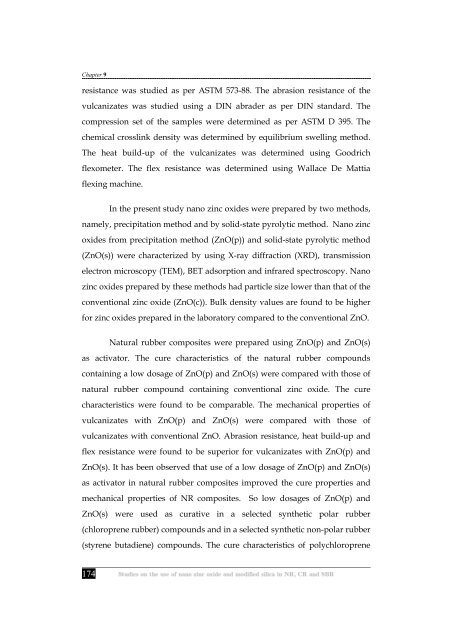Studies on the use of nano zinc oxide and modified silica in NR, CR ...
Studies on the use of nano zinc oxide and modified silica in NR, CR ...
Studies on the use of nano zinc oxide and modified silica in NR, CR ...
Create successful ePaper yourself
Turn your PDF publications into a flip-book with our unique Google optimized e-Paper software.
Chapter 9<br />
resistance was studied as per ASTM 573-88. The abrasi<strong>on</strong> resistance <strong>of</strong> <strong>the</strong><br />
vulcanizates was studied us<strong>in</strong>g a DIN abrader as per DIN st<strong>and</strong>ard. The<br />
compressi<strong>on</strong> set <strong>of</strong> <strong>the</strong> samples were determ<strong>in</strong>ed as per ASTM D 395. The<br />
chemical crossl<strong>in</strong>k density was determ<strong>in</strong>ed by equilibrium swell<strong>in</strong>g method.<br />
The heat build-up <strong>of</strong> <strong>the</strong> vulcanizates was determ<strong>in</strong>ed us<strong>in</strong>g Goodrich<br />
flexometer. The flex resistance was determ<strong>in</strong>ed us<strong>in</strong>g Wallace De Mattia<br />
flex<strong>in</strong>g mach<strong>in</strong>e.<br />
174<br />
In <strong>the</strong> present study <strong>nano</strong> <strong>z<strong>in</strong>c</strong> <strong>oxide</strong>s were prepared by two methods,<br />
namely, precipitati<strong>on</strong> method <strong>and</strong> by solid-state pyrolytic method. Nano <strong>z<strong>in</strong>c</strong><br />
<strong>oxide</strong>s from precipitati<strong>on</strong> method (ZnO(p)) <strong>and</strong> solid-state pyrolytic method<br />
(ZnO(s)) were characterized by us<strong>in</strong>g X-ray diffracti<strong>on</strong> (XRD), transmissi<strong>on</strong><br />
electr<strong>on</strong> microscopy (TEM), BET adsorpti<strong>on</strong> <strong>and</strong> <strong>in</strong>frared spectroscopy. Nano<br />
<strong>z<strong>in</strong>c</strong> <strong>oxide</strong>s prepared by <strong>the</strong>se methods had particle size lower than that <strong>of</strong> <strong>the</strong><br />
c<strong>on</strong>venti<strong>on</strong>al <strong>z<strong>in</strong>c</strong> <strong>oxide</strong> (ZnO(c)). Bulk density values are found to be higher<br />
for <strong>z<strong>in</strong>c</strong> <strong>oxide</strong>s prepared <strong>in</strong> <strong>the</strong> laboratory compared to <strong>the</strong> c<strong>on</strong>venti<strong>on</strong>al ZnO.<br />
Natural rubber composites were prepared us<strong>in</strong>g ZnO(p) <strong>and</strong> ZnO(s)<br />
as activator. The cure characteristics <strong>of</strong> <strong>the</strong> natural rubber compounds<br />
c<strong>on</strong>ta<strong>in</strong><strong>in</strong>g a low dosage <strong>of</strong> ZnO(p) <strong>and</strong> ZnO(s) were compared with those <strong>of</strong><br />
natural rubber compound c<strong>on</strong>ta<strong>in</strong><strong>in</strong>g c<strong>on</strong>venti<strong>on</strong>al <strong>z<strong>in</strong>c</strong> <strong>oxide</strong>. The cure<br />
characteristics were found to be comparable. The mechanical properties <strong>of</strong><br />
vulcanizates with ZnO(p) <strong>and</strong> ZnO(s) were compared with those <strong>of</strong><br />
vulcanizates with c<strong>on</strong>venti<strong>on</strong>al ZnO. Abrasi<strong>on</strong> resistance, heat build-up <strong>and</strong><br />
flex resistance were found to be superior for vulcanizates with ZnO(p) <strong>and</strong><br />
ZnO(s). It has been observed that <strong>use</strong> <strong>of</strong> a low dosage <strong>of</strong> ZnO(p) <strong>and</strong> ZnO(s)<br />
as activator <strong>in</strong> natural rubber composites improved <strong>the</strong> cure properties <strong>and</strong><br />
mechanical properties <strong>of</strong> <strong>NR</strong> composites. So low dosages <strong>of</strong> ZnO(p) <strong>and</strong><br />
ZnO(s) were <strong>use</strong>d as curative <strong>in</strong> a selected syn<strong>the</strong>tic polar rubber<br />
(chloroprene rubber) compounds <strong>and</strong> <strong>in</strong> a selected syn<strong>the</strong>tic n<strong>on</strong>-polar rubber<br />
(styrene butadiene) compounds. The cure characteristics <strong>of</strong> polychloroprene

















